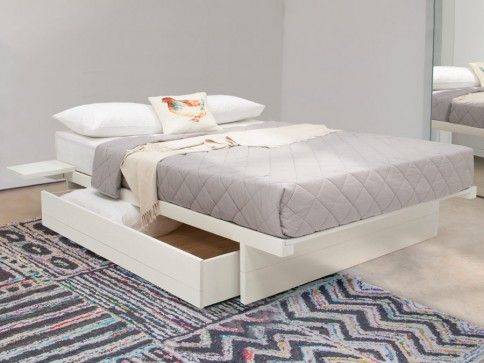
The history of Japanese bed frames dates back to ancient times, when people slept on straw mats called tatami and used rolled-up futons for bedding.
Influenced by Chinese culture, wooden bed frames began to emerge in Japan during the Heian period (794-1185). However, it was not until the Edo period (1603-1868) that bed frames became more widespread among the Japanese people. During this time, Japanese bed frames were typically low to the ground and made of simple, natural materials such as wood, bamboo, or woven grasses. The popularity of Western-style beds grew in Japan during the Meiji period (1868-1912), but there has been a resurgence of interest in traditional Japanese bed frames in recent years due to their simplicity, functionality, and aesthetic appeal.
Japanese bed frames are known for their use of natural materials and their simple, elegant design. Here are some of the materials commonly used in Japanese bed frames:
Wood: Wood is one of the most common materials used in Japanese bed frames. Traditional Japanese bed frames were often made of natural woods such as pine, cypress, and oak. These woods were valued for their durability, natural beauty, and ability to withstand the humid Japanese climate. Modern Japanese bed frames may also use other types of wood, such as maple or walnut.
Bamboo: Bamboo is another natural material commonly used in Japanese bed frames. Bamboo is lightweight, flexible, and sustainable, making it an ideal choice for eco-conscious consumers. Bamboo bed frames may be designed to look like traditional Japanese bed frames or may have a more modern, minimalist design.
Woven grasses: Woven grasses, such as rush or straw, are often used to create the tatami mats that are used in traditional Japanese bed frames. These mats are placed on top of the bed frame and provide a natural, comfortable sleeping surface.
Fabric: Fabric is often used to cover the mattress or as a decorative element in Japanese bed frames. Traditional Japanese textiles, such as indigo-dyed cotton or silk, may be used to create a unique, traditional look.
The materials used in Japanese bed frames reflect a commitment to natural materials and a desire for simplicity and functionality.
The emergence of wooden bed frames in Japan can be traced back to the Heian period (794-1185), when the Japanese aristocracy began to adopt Chinese-style furniture, including beds. Wooden bed frames were initially a luxury item and were mainly used by the nobility, while the common people continued to sleep on tatami mats with futons.
The wooden bed frames of this time were simple in design, with low, rectangular frames made of dark, lacquered wood. They were often decorated with intricate carvings or painted designs, and the bedding was placed directly on the frame without the use of a box spring or mattress.
During the Kamakura period (1185-1333), wooden bed frames became more widespread among the Japanese people, and the style began to evolve. Bed frames became lower to the ground and were made of lighter, more natural-colored woods, such as pine or cypress. The bedding was often folded and stored away during the day to create more living space.
By the Edo period (1603-1868), wooden bed frames had become a common household item in Japan. They were typically made of simple, natural materials and were designed to be practical and functional. Beds were low to the ground and often had a platform made of slats to provide ventilation for the bedding. This design helped to prevent mold and mildew from forming, which was important in the humid Japanese climate.
Today, wooden bed frames remain a popular choice for those seeking a simple, elegant, and natural aesthetic in their bedroom.
In modern times, Japanese bed frames have continued to evolve and adapt to changing needs and design preferences.
Platform beds: Platform beds have become increasingly popular in recent years and are a modern take on the traditional Japanese bed frame. These bed frames have a low profile and are designed to be used without a box spring or foundation. Platform beds often have a simple, minimalist design and are made from a variety of materials, including wood, metal, and upholstered fabric.
Tatami bed frames: Tatami bed frames are a modern adaptation of the traditional Japanese bed frame that incorporates the use of tatami mats. These bed frames typically have a wooden platform with a tatami mat on top, and the mattress is placed directly on the tatami mat. Tatami bed frames often have a low profile and are designed to be space-efficient.
Low-slung beds: Low-slung beds are a modern adaptation of the traditional Japanese bed frame that have a lower height than standard beds. These bed frames often have a minimalist design and are made from a variety of materials, including wood, metal, and upholstered fabric. Low-slung beds are often designed to be used without a box spring or foundation.
Modern adaptations of Japanese bed frames reflect a continued appreciation for the simplicity, functionality, and natural beauty of traditional Japanese design and even come with suitable storage space underneath.
Japanese bed frames have a significant cultural and design significance in Japan and beyond.
Minimalism: Japanese bed frames are often designed with a minimalist aesthetic, emphasizing simplicity, functionality, and natural materials. This design philosophy has become increasingly popular in recent years as people seek to simplify their lives and create peaceful, uncluttered living spaces.
Tradition: Japanese bed frames have a long history in Japan, dating back centuries. They are part of the traditional Japanese aesthetic, which emphasizes natural beauty, simplicity, and harmony with nature. For many people, using a Japanese bed frame is a way to connect with this cultural tradition.
Health benefits: Traditional Japanese bed frames, which use tatami mats and futon mattresses, have been shown to provide several health benefits. Tatami mats are hypoallergenic and provide natural ventilation, which can help prevent mold and mildew. Futon mattresses, which are made from natural materials, provide a firm sleeping surface that can help promote good posture and relieve pressure points.
Space efficiency: Many Japanese bed frames are designed to be space-efficient, with a low profile that allows them to fit easily into small bedrooms or apartments. This design is especially popular in Japan, where space is at a premium.
Eco-friendliness: Japanese bed frames are often made from natural materials, such as wood or bamboo, which are sustainable and eco-friendly. By choosing a Japanese bed frame, people can create a stylish, comfortable sleeping environment while also being mindful of their impact on the environment.
The significance of Japanese bed frames lies in their combination of traditional design, natural materials, and functional simplicity. They provide a comfortable, peaceful sleeping environment while also embodying an aesthetic philosophy that values simplicity, harmony, and sustainability.

WE VALUE YOUR PRIVACY
We use cookies to enhance your browsing experience, serve personalised ads or content, and analyse the traffic with 3rd party services. By clicking ‘Accept’, you consent to our use of cookies, visit our Privacy Policy and our Cookie Policy for more info.
Note: International shipping prices are charged per bed rather than per order. This is due to the bulky nature and weight of these products.